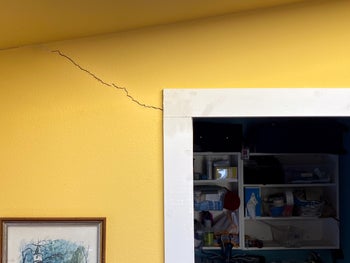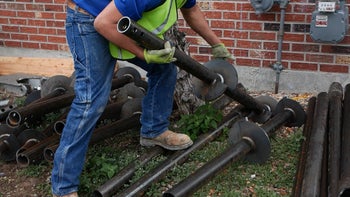Common Problems With Pier And Beam Foundations
Table of Contents
1. What Is A Pier And Beam Foundation
2. Benefits Of A Pier And Beam Foundation
3. Common Problems With Pier And Beam Foundations
4. Common Signs Of Foundation Problems
5. How Is A Pier And Beam Foundation Repaired?
6. Tips On How To Prevent Foundation Problems
Looking for information about pier and beam foundations? If so, you’ve landed on the right page because that’s what we’re going to talk about in this article. We’ll go over what is a pier and beam foundation, common problems with them, how these problems are repaired, and more.
What Is A Pier And Beam Foundation
A pier and beam foundation is a type of foundation commonly used in residential construction projects. Footings, typically concrete or wood, are spaced across the site in a grid-like pattern. These footings are then connected by beams, which form a durable and stable framework upon which the house can be built.
Benefits Of A Pier And Beam Foundation
One of the main advantages of pier and beam foundations is that they can provide significant support for the structure while also allowing for flexibility. Because the piers are spaced out and not connected to each other directly, the foundation can absorb some of the natural movements that occur in the ground over time without causing undue stress or damage to the structure.
Another advantage of pier and beam foundations is that they can be built in various soil types. This is because the piers can be adjusted in height to compensate for any variations in the soil depth or composition.
Additionally, because the piers are spaced out rather than forming a solid mass, pier and beam foundations can be built over areas challenging to dig or with natural obstructions such as tree roots or rocks.
When constructed properly, a pier and beam foundation can provide a strong and durable base to build various structures. It’s an excellent choice for homes, commercial buildings, and other structures that need to be built on uneven or unstable soil. With proper maintenance and upkeep, a pier and beam foundation can last for many years, providing a solid base for any building.
Pier and beam foundations also provide easy access to the home’s wiring, plumbing, and HVAC system.
If the area under the house is enclosed, it becomes a crawl space foundation. Crawl spaces, when encapsulated, can be used to store things like holiday decorations and tools.
Common Problems With Pier And Beam Foundations
Although pier and beam foundations have been popular with homeowners for decades, that doesn’t mean they’re not without their downsides. These include the following:
- Moisture damage – Because this type of foundation is elevated off the ground, it can be susceptible to moisture and humidity if the area under the house is surrounded by walls, making it a crawl space foundation. If not encapsulated, the crawl space underneath the foundation can become damp and promote mold growth, resulting in health hazards and structural damage caused by wood rot.
- Pest infestations – Termites can wreak havoc on pier and beam foundations. Unless the crawl space is encapsulated, insects can easily access the wooden beams and joists that support the foundation, leading to potential structural damage. If the crawl space is unencapsulated, homeowners should regularly inspect the area to ensure it’s termite-free.
- More expensive to build – Pier and beam foundations can be more costly than slab foundations. This is due to the extra labor and materials required to install the piers and beams.
- Reduced air quality inside your home – Because some of the air in the crawl space flows into your home’s living area, the crawl space needs to be mold-free. Mold spores in the crawl space air mean reduced air quality inside the house.
- An inadequate number of piers (or piers that aren’t big enough) – Sometimes, due to improper design, the number or type of piers used isn’t adequate to properly support the house.
- Soil Movement – Although often suitable for different soil types, pier and beam foundations can experience movement or settlement due to soil conditions. Expansive soil or clay soil can cause the piers to settle.
Of course, pier and beam foundations are, like all foundations, susceptible to differential settlement or when a foundation settles into the ground unevenly. This can occur for various reasons and puts a lot of stress on the foundation leading to structural damage. For more information, see Foundation Settlement.
Common Signs Of Foundation Problems
Here are some red flags that your home’s foundation may be compromised:
- You may notice cracks in your walls, ceiling, or flooring. These can appear as hairline fissures or be gaping or jagged.
- Doors and windows may not open and close as easily as they used to. They may become stuck or require excessive force to move.
- Your basement or crawlspace may develop an unpleasant odor or become moist, indicating water damage, which may occur due to the cracks in the foundation.
- Uneven floors, where some parts of rooms may be sloping or sinking, can also indicate foundation issues.
- You may hear creaking or popping sounds that weren’t present before, resulting from stress on the foundation.
- Stair step cracks in brick or masonry
- The exterior siding may show signs of damage, such as bulging or separating from the house.
- You may notice that your chimney or porch is leaning away from the house.
If you notice any of these signs – or anything else that seems suspicious – your home’s foundation may be compromised. Contact a professional foundation repair specialist right away and ask for an inspection. If you wait, the problem will only worsen, and you’ll pay more for the repair.
How Is A Pier And Beam Foundation Repaired?
Any chosen repair solution depends on what caused the problem. Is the problem foundation settlement, settled support posts, or a cracked foundation wall caused by hydrostatic pressure?
To repair a pier and beam foundation, a qualified foundation repair contractor will first assess the extent of the damage and the cause of the problem. Once the problem is identified, the repair process may include any of the following:
- Underpinning using either push or helical piers – If the problem is differential settlement, the solution is to extend the foundation to load-bearing soil via underpinning.
- Shoring up the beams – If the wooden beams are sagging or damaged, they may need to be reinforced or replaced with more robust materials.
- Replacing support posts with screw jacks – If the support posts in the crawl space are no longer vertical due to soggy soil, they may need to be replaced with adjustable screw jacks.
- Carbon fiber straps to repair a cracked or bowed foundation wall – Carbon fiber straps may be one solution if the foundation wall is cracked and/or bowed due to hydrostatic pressure.
It’s important to note that repairing a pier and beam foundation can be a complex and costly process, so working with a reputable foundation repair contractor with the necessary skills and experience to get the job done right is crucial.
Tips On How To Prevent Foundation Problems
Because water causes most foundation problems, homeowners can go a long way toward preventing issues by controlling groundwater around the foundation. Here are some ways to do that:
- Install a drain tile system – A drain tile system is a network of perforated pipes installed around the outside of the foundation at the footing level. The purpose of these pipes is to collect excess water and direct it away from the foundation. This can be especially important in areas prone to heavy rainfall or with a high water table. Installing a drain tile system can be a significant investment, but it’s the most effective foundation waterproofing system.
- Install downspout extensions – Downspout extensions are pieces of piping that attach to your gutters and direct water away from your home’s foundation before releasing it.
- Clean gutters regularly – Keeping gutters clean and free of debris is essential. Clogged gutters can lead to water spilling over and collecting near the foundation, which can cause problems over time.
- Don’t plant water-hungry vegetation next to the house – You don’t want to give yourself a reason to add water to the soil around the foundation.
- If necessary, regrade your yard so that it slopes away from the house – This will prevent groundwater from draining toward the foundation.
By taking these steps and being proactive about maintaining your home’s foundation, you can prevent many foundation problems from occurring in the first place. While it may require some effort and investment upfront, it can ultimately save you time, money, and headaches in the long run.
If you’re concerned about an issue with your pier and beam foundation home, contact us today to schedule an evaluation. We serve all of Northern California.
More Resources
Publish Date:
Last Modified Date:

Our Locations
2333 Courage Dr. Suite C
Fairfield, CA 94533
1161 N Fair Oaks Ave
Sunnyvale, CA 94089



